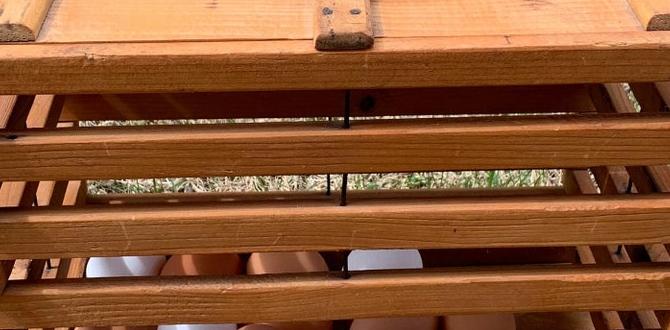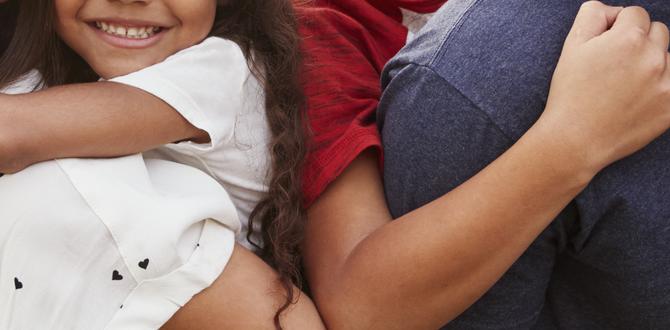Have you ever noticed your dog acting restless when you leave the house? Many pet owners face this problem. It’s called separation anxiety. It can be tough for both pet and owner. But there’s hope! Crate training can help ease these feelings.
Imagine coming home to a happy pup instead of a worried one. Crate training might be the answer. Did you know that dogs often find comfort in a cozy space? A crate can become a safe haven for your furry friend.
In this article, we will explore how crate training can reduce separation anxiety. We will give you tips and tricks to make the process easier. Your dog will feel more secure, and you will feel more at ease when leaving home.
Ready to turn those anxious barks into joyful wags? Let’s dive into the world of crate training and discover how it can change your dog’s life for the better.
Effective Crate Training To Overcome Separation Anxiety

Crate Training and Separation Anxiety
Crate training can be a game changer for dogs with separation anxiety. It offers a safe space for pets to relax when left alone. Many dogs feel more secure in a crate, which reduces fear and stress. Did you know that starting crate training early can help your dog cope better? Gradual introduction is key. Creating positive associations with the crate helps dogs feel at ease. With patience and practice, you can help your furry friend gain confidence.Understanding Separation Anxiety in Dogs
Definition and symptoms of separation anxiety. Common causes and risk factors.Separation anxiety in dogs happens when they feel very upset when left alone. Symptoms include barking, chewing, and digging. Imagine a dog that thinks its owner disappeared like a magician! Common causes can be moving to a new home, changes in family, or a lack of socialization. Puppies are at higher risk because they might not be used to being alone. Keeping an eye on your dog’s behavior can help spot this early. Here’s a quick table showing some signs:
| Symptoms | Possible Causes |
|---|---|
| Barking | Change in routine |
| Chewing furniture | Moving to a new home |
| Hiding | Lack of socialization |
By understanding these signs, you can help your furry friend feel more comfortable and secure!
The Importance of Crate Training
Benefits of crate training for dogs. How crate training aids in reducing anxiety.Crate training offers many benefits for dogs and their owners. It can help dogs feel safe and secure. A crate acts as a cozy home where dogs can relax. This can reduce anxiety when left alone. Here are some key benefits:
- Provides a safe space for dogs
- Helps with house training
- Creates a routine for feeding and sleeping
- Reduces the chance of destructive behavior
When dogs have their own space, they feel less worried. This makes it easier for them to cope with being alone.
How does crate training help with separation anxiety?
Crate training helps ease separation anxiety by giving dogs a secure spot to relax. This can make them feel more at ease while their owners are away.
Choosing the Right Crate
Types of crates available on the market. Factors to consider when selecting a crate size and style.Choosing the right crate is a big deal. Crates come in many types. You can find soft-sided crates for travel, wire crates for easy visibility, and plastic ones for snugness. Size is key! Your dog should stand, turn around, and lie down comfortably. If the crate is too big, it might feel like a doggy carnival, which can be scary. So measure your pup! For added fun, think of it as their special “den” where every nap is an adventure. Remember, happy dog, happy life!
| Crate Type | Best for |
|---|---|
| Soft-Sided | Travel |
| Wire | Visibility |
| Plastic | Cozy feelings |
Establishing a Positive Crate Environment
Techniques to make the crate a comfortable space. Using positive reinforcement to encourage crate use.Creating a cozy crate is like building a special fort for your pup. Start by adding soft blankets and comfy bedding. Toss in a favorite toy or two. This makes the crate a fun hangout, not a scary box! Use treats and praise when your dog enters the crate. Think of it as a game: “Hey, what’s in here?” Dogs love surprises! Remember, a happy pup is less likely to feel anxious when you leave.
| Tip | Description |
|---|---|
| Comfort | Use soft bedding and familiar items to make the crate welcoming. |
| Positive Reinforcement | Reward your dog with treats and praise for going inside. |
Step-by-Step Crate Training Process
Initial familiarization with the crate. Gradual increasing time spent in the crate. Incorporating rewards and treats.To start crate training, let your pet explore the crate. Place it in a cozy spot. Keep the door open. Allow your dog to go in and out freely. Next, slowly increase their time inside. Begin with short periods, then lengthen it. Remember to add rewards. Give treats when they enter the crate. This builds a positive connection. Your pet will see the crate as a safe space.
What is the purpose of crate training?
The purpose of crate training is to help your dog feel safe. It can also reduce separation anxiety. A crate provides a calm place for your pet. This can improve their behavior at home.
Tips for Successful Crate Training:
- Choose the right size crate.
- Use comfort items like a favorite blanket.
- Be patient and encouraging.
Addressing Common Challenges in Crate Training
Handling excessive barking or whining. Overcoming fear or resistance to the crate.Many puppies bark or whine when in a crate. This can be tough, but patience helps. Try these tips to calm your puppy:
- Cover the crate with a blanket to make it cozy.
- Give them a toy or treat to distract them.
- Start with short crate times, then gradually increase.
Some dogs fear their crate. To help them feel safe, use positive reinforcement. Give treats when they enter the crate. Customize their space with soft bedding. Also, let them explore it freely. With time and patience, your puppy will love their crate.
How do I stop my dog from barking in the crate?
To stop barking, provide rewards for quiet time and limit crate use gradually. This approach builds their comfort and trust in the crate.
What if my dog is scared of the crate?
Introduce the crate slowly and encourage exploration. This helps dogs see the crate as a safe space.
When to Seek Professional Help
Recognizing signs that professional intervention is necessary. Resources for finding a qualified dog trainer or behaviorist.Many dog owners may notice signs that their pet needs extra help. If your dog shows extreme fear or stress when left alone, it’s time to reach out for support. Other signs include ongoing barking, destructive behavior, or refusing to eat. These behaviors can mean your dog is struggling.
Finding a good trainer or behaviorist is crucial. Start with these tips:
- Check local pet stores for recommendations.
- Visit online platforms like Yelp or Google reviews.
- Ask your veterinarian for trusted referrals.
Seeking help is a smart choice. Your dog’s comfort and happiness come first!
What signs mean I need professional help?
Look for signs like constant barking, hiding, or destructive behavior. These may show your dog is very anxious when alone.
Long-Term Strategies for Reducing Separation Anxiety
Daily routines and exercise to promote confidence. Gradual desensitization to departures and arrivals.Establishing daily routines and a good exercise plan can help your furry friend feel more confident. A tired dog is a happy dog, especially when they are worn out from playtime. Short walks or fun games can work wonders!
For easing separation anxiety, try practicing short departures. Leave your pup alone for just a few minutes, then return. It’s like a puppy game of hide-and-seek! This helps them get used to you being gone.
| Tip | Description |
|---|---|
| Daily Exercise | Walk, play, and romp to boost confidence! |
| Short Departures | Practice leaving for brief moments. |
Consistency is key! Keep at these strategies, and soon, your pup will be barking, “Goodbye, have fun!” instead of worrying. It’s all about making them feel safe and secure.
Conclusion
In conclusion, crate training can help your dog feel safe when you’re away. It reduces separation anxiety and builds confidence. Start slowly, using positive reinforcement to make your dog comfortable. Remember, patience is key. For more tips and guidance, consider reading further about crate training techniques. Together, we can help your furry friend feel happy and relaxed!FAQs
What Are The Signs Of Separation Anxiety In Dogs, And How Can Crate Training Help Alleviate This Issue?Signs of separation anxiety in dogs include barking, whining, or chewing on things when you’re gone. They might also follow you everywhere or act very clingy. To help with this, crate training can be useful. When you crate train, you create a safe space for your dog to relax while you’re away. It makes them feel secure and can help them learn to be alone for a while.
How Can I Gradually Acclimate My Dog To Their Crate To Prevent Separation Anxiety?To help your dog get used to their crate, start by making it a fun place. You can put their favorite toys or a cozy blanket inside. Then, let them explore the crate with the door open. Give them treats when they go inside. Gradually close the door for a little while each time, and always stay nearby so they feel safe.
What Techniques Can I Use To Make The Crate More Inviting And Comfortable For My Dog?To make the crate cozy for your dog, start by adding a soft blanket or dog bed inside. You can place their favorite toys in there too. Make sure the crate is in a quiet, safe spot where your dog feels relaxed. You can also use treats or snacks to encourage your dog to go inside. Lastly, spend time with your dog near the crate to help them feel more at home!
Are There Specific Training Exercises That Can Strengthen My Dog’S Ability To Cope With Being Alone In A Crate?Yes, there are exercises to help your dog feel better in a crate. Start by giving them treats when they go inside. Then, close the door for a short time while you stay nearby. Gradually, you can leave the room for a little bit. Make sure to come back and reward your dog for being calm. This helps them feel safe and happy when they are alone.
What Should I Do If My Dog Experiences Extreme Distress While In The Crate Despite My Training Efforts?If your dog is very upset in the crate, you can try some new things. First, make the crate cozy with soft blankets. Next, give your dog a special toy to play with inside the crate. You can also leave the door open sometimes and let your dog explore it. If things don’t get better, talk to a vet or a dog trainer who can help you more.
Meet Elyse Colburn, the devoted canine companion and storyteller behind the enchanting world of “Tales, Tails, and Adventures Unleashed.” A passionate dog enthusiast with a heart full of paw prints, Elyse Colburn shares heartwarming tales and insightful adventures, celebrating the joy, loyalty, and endless antics that make every dog a true hero. Join Elyse Colburn on this tail-wagging journey, where every post is a love letter to our four-legged friends.








